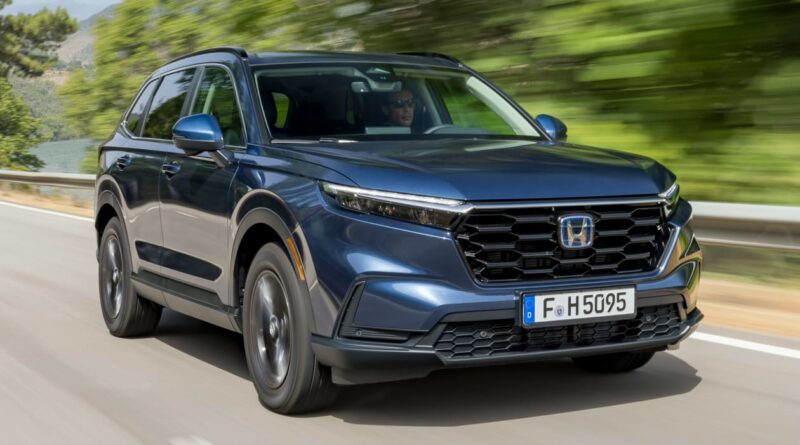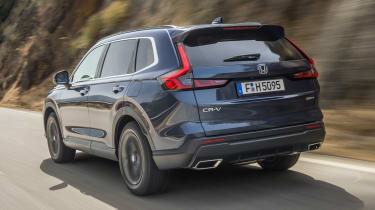New Honda CR-V Hybrid 2023 review
The new Honda CR-V is an improvement over the car it replaces, but the jump in price will put many off
3.5 out of 5
How we review carsBuy used for less at Buyacar
Verdict
Honda’s CR-V is a better product than before, but it really needs to be when you take into account the price inflation. The user-friendly interior and overall refinement will be a clincher for many prospective buyers, although the lacklustre powertrain will be a turn off for many more.
The Honda CR-V has arrived for its sixth generation and it comes with quite an important addition to the range in the form of a plug-in hybrid model. We were a little underwhelmed by the new PHEV CR-V, but Honda has sensibly decided to retain the full-hybrid option with the new car – which is what we’re driving here.
Now, almost every mainstream car manufacturer has a mild or full-hybrid SUV the size of the CR-V in its range, so Honda certainly has its work cut out to really shine in this segment. Honda notes that its rivals range from cheaper offerings like the Renault Austral and Nissan X-Trail to the premium end of the market with cars such as the Land Rover Discovery Sport and BMW X3.
The Honda is priced like a premium car though. Entry-level Elegance starts from £45,895 and our car in its Advance trim level kicks off at £48,995 – the plug-in hybrid, available only in Advance Tech, weighs in at a sizeable £53,995.
More reviews
Car group tests
- Toyota RAV4 vs Honda CR-V
- Honda CR-V (2017-2023) review
- Honda CR-V review
- New Honda CR-V 2023 review
- New Honda CR-V Hybrid 2019 review
- New Honda CR-V 2018 review
- Used Honda CR-V (Mk5, 2019-date) review
- Used Honda CR-V (Mk4, 2012-2017) review
In-depth reviews
Road tests
Used car tests
It’s just as well the CR-V is pretty well-equipped then. As standard you get a panoramic glass roof, leather and heated seats, an electric boot lid, a rear-view camera, automatic headlights, a drive mode system, a wireless smartphone charger, keyless entry and Honda’s Sensing 360 safety technology.
Step up to this Advance model and you’ll get an uprated sound system, memory adjustment for the driver’s seat, a head-up display, heated rear seats and ventilated front seats, a heated steering wheel, cornering lights and adaptive headlights.
Honda has taken a refreshingly sensible and user-friendly approach to the CR-V’s interior – forgoing the glitzy huge screen and minimalist environment many of its rivals opt for. It’s similar to the Civic’s, which is no bad thing, but perhaps a little disappointing given the higher price tag of the CR-V. All the car’s most frequently-used functions are easily within reach, usually operated by a physical button or switch. Everything feels properly screwed together – certainly as well as any premium offering that the CR-V will go up against.
The latest generation is also the biggest CR-V ever. An extra 106mm in total length over the outgoing car frees up 38mm in wheelbase length, meaning there’s an extra 15mm of rear legroom. In some markets the CR-V is even offered with seven-seats, but this model won’t come to the UK, mainly because of its 1.5-litre non-hybrid powertrain.
Unlike pretty much every other car that comes with a plug-in hybrid and mild-hybrid, the CR-V PHEV has the bigger boot at 635 litres compared to the hybrid’s 596 litres. This is because the PHEV’s battery is located under the rear seats, where the hybrid’s is under the boot floor to help with the necessary cooling.
The powertrain is overall fairly linear with its deployment of power though. With 184bhp and 189Nm of torque, you’d call performance ‘adequate’ at best. The CR-V certainly feels like its 9.5-second 0-62mph time for the most part.
The overall sensation of relaxation while sitting behind the wheel of the CR-V is bolstered by the excellent visibility. It’s easy to position on the road despite being 11mm wider than before. Efficiency is about average for the class with the claimed 42.8mpg a reasonably achievable figure.
Honda makes a big deal over its Sensing 360 safety technology, and in the CR-V it’s fairly hit and miss. We found the road sign display to be spot on and the 360 degree radar is useful around town, but the lane keep assist is infuriating. There’s a camera on the passenger side wing mirror which displays your blind spot on the central screen when indicating. That means you can no longer see the sat-nav (or any other information) on the central screen and we worry some drivers will resort to simply not indicating to ensure the feed isn’t on display. Thankfully you can turn off the camera in a sub menu (and it remains off when turning the engine off and on), but this technology feels a bit redundant to us.
Our biggest gripe with the hybrid CR-V is the same as the plug-in hybrid – the price. Honda has taken aim at the more premium end of the market and in many ways the CR-V matches rivals from BMW, Audi and Lexus, but a few crucial missing attributes such as the powertrain let it down.
| Model: | Honda CR-V Advance e:HEV |
| Price: | £48,995 |
| Engine: | 2.0-litre four-cylinder hybrid |
| Power/torque: | 184bhp/189Nm |
| Transmission: | e-CVT automatic |
| 0-62mph: | 9.5 seconds |
| Top speed: | 116mph |
| Economy: | 42.8mpg |
| CO2: | 151g/km |
| On sale: | Now |
Source: Read Full Article








